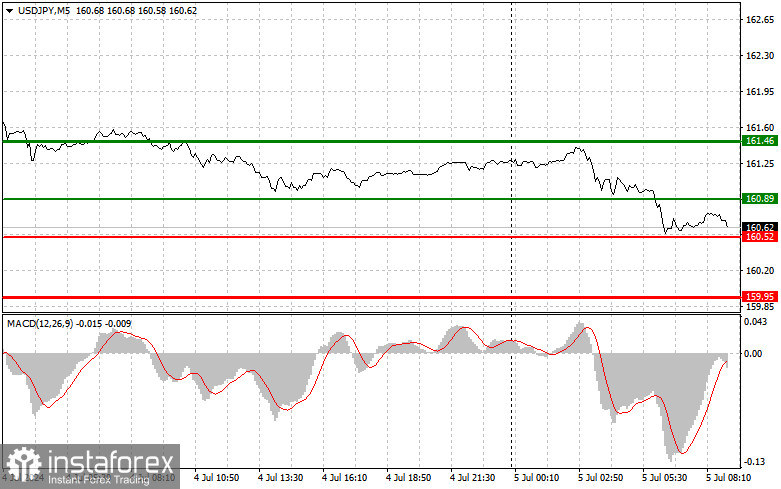Overview of trading and tips on USD/JPY
There were no price tests of the levels I mentioned in the U.S. session, so we did not get any good entry points. The U.S. holiday was the main reason why volatility was low. Despite the circumstances, sellers were determined to trade actively in today's Asian session, which led to the test of the weekly lows. Even weak data on household spending, which sharply decreased, did not hinder the pair's correction. The figures for the index of leading economic indicators matched economists' forecasts, but traders ignored this report. It is clear that the pair's further direction will entirely depend on the U.S. labor market data, and until then, we are unlikely to see a breakout and consolidation below the daily low. For this reason, I will try to look for reversal entry points, in anticipation of a small bullish correction. As for the intraday strategy, I will rely more on the implementation of scenarios No. 1 and 2.

Buy signals
Scenario No. 1. Today, I plan to buy USD/JPY when the price reaches the entry point at 160.89 plotted by the green line on the chart, aiming for growth to 161.46 plotted by the thicker green line on the chart. Around 161.46, I'm going to exit long positions and open short ones in the opposite direction, expecting a movement of 30-35 pips in the opposite direction from that level. You can count on the pair to rise today after actively defending the intraday low. Before buying, make sure that the MACD indicator is above the zero mark and is just starting to rise from it.
Scenario No. 2. I also plan to buy USD/JPY today in case of two consecutive tests of 160.52 when the MACD indicator is in the oversold area. This will limit the pair's downward potential and lead to a reverse market upturn. One can expect growth to the opposite levels of 160.89 and 161.46.
Sell signals
Scenario No. 1. I plan to sell USD/JPY today only after testing the level of 160.52 plotted by the red line on the chart, which will lead to a rapid decline in the price. The key target for sellers will be 159.95, where I am going to exit short positions and immediately open long ones in the opposite direction, expecting a movement of 20-25 pips in the opposite direction from that level. Pressure on USD/JPY may return at any moment within the bearish correction. Before selling, make sure that the MACD indicator is below the zero mark and is just starting to decline from it.
Scenario No. 2. I also plan to sell USD/JPY today in case of two consecutive price tests at 160.89 when the MACD indicator is in the overbought area. This will limit the pair's upward potential and lead to a reverse market downturn. One can expect a decline to the opposite levels 160.52 and 159.95.

What's on the chart:
The thin green line is the entry price at which you can buy the trading instrument.
The thick green line is the estimated price where you can set Take-Profit (TP) or manually close positions, as further growth above this level is unlikely.
The thin red line is the entry price at which you can sell the trading instrument.
The thick red line is the price where you can set Take-Profit (TP) or manually close positions, as further decline below this level is unlikely.
MACD line: it is important to be guided by overbought and oversold areas when entering the market
Important: Novice traders in the forex market need to be very careful when making decisions to enter the market. It is best to stay out of the market before important fundamental reports are released to avoid getting caught in sharp price fluctuations. If you decide to trade during news releases, always place stop orders to minimize losses. Without setting stop orders, you can quickly lose your entire deposit, especially if you don't use money management and trade in large volumes.
And remember, for successful trading, it is necessary to have a clear trading plan, similar to the one I presented above. Spontaneously making trading decisions based on the current market situation is inherently a losing strategy for an intraday trader.





















